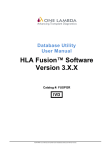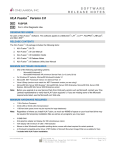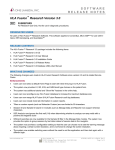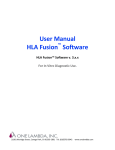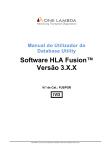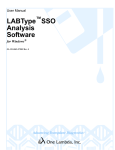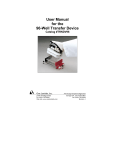Download Fusion Research Database Utility User Manual v3_0
Transcript
User Manual Database Utility HLA Fusion Research Software Version 3.0 HLAF-INSTALL-v3.x.x-EN-00, Rev 0 (HLA Fusion Research Database Utility Guide v3_0) One Lambda, Inc. HLA Fusion Research Version 3.0 Database Utility Guide All of One Lambda software products are designed to assist personnel experienced in HLA analysis by suggesting typing results. However, any clinical or diagnostic results must be carefully reviewed by a person qualified in HLA typing to assure correctness. This software may be used to aid in suggesting results, but should not be used as the sole method for determining reportable results. This software is meant as a laboratory aid, not as a source of definitive results. The software design does not mitigate hazards associated with the software. The laboratory director or technologist trained in histocompatibility testing is required to review all data to detect any problems with the software. Please note that this document was prepared in advance of the HLA Fusion Research software release. Therefore, you may notice slight differences in the content of the actual application screens. For Research Use Only. Not for use in diagnostic procedures. 21001 Kittridge Street, Canoga Park, CA 91303-2801 Tel: 818.702.0042 • Fax: 818.702.6904 www.onelambda.com LABType®, LABScreen® and FlowPRA® are registered trademarks of One Lambda, Inc. HLA Fusion™, LCT™, LAT™, Micro SSP™ and LABScan™ 100 are trademarks of One Lambda, Inc. Luminex® is a registered trademark of Luminex Corporation. Windows® is a registered trademark of Microsoft Corporation. © Copyright 2012, One Lambda, Inc. All rights reserved. March 2012 HLAF-MAN-v3.x.x-EN-01, Rev 0 (HLA Fusion Research Database Utility Guide v3_0) ii One Lambda, Inc. HLA Fusion Research Version 3.0 Database Utility Guide Table of Contents Opening the HLA Fusion Database Utility ........................................................................................................... 2 Database Tasks ................................................................................................................................................... 4 Creating a New Database ................................................................................................................................ 4 Selecting and Connecting to a Database......................................................................................................... 6 Attaching to a Database ................................................................................................................................... 9 Detaching from a Database ........................................................................................................................... 11 Deleting a Scheduled Backup ........................................................................................................................ 16 Restoring a Database .................................................................................................................................... 17 Merging Databases ........................................................................................................................................ 19 Create/Select an Audit Log Database............................................................................................................ 21 Optimizing a Fusion Database ....................................................................................................................... 23 Scheduling Database Optimization ................................................................................................................ 25 Reconfiguring a Fusion Database .................................................................................................................. 26 Merging an Audit Log Database .................................................................................................................... 27 Current Database Details ............................................................................................................................... 28 Data Migration .................................................................................................................................................... 29 Upgrade Prior Database Versions to HLA Fusion Database 3.0 ................................................................... 29 HLAF-MAN-v3.x.x-EN-01, Rev 0 (HLA Fusion Research Database Utility Guide v3_0) iii One Lambda, Inc. HLA Fusion Research Version 3.0 Database Utility Guide HLA Fusion™ Database Utility With the HLA Fusion™ Research Database Utility, you can access and select a SQL Server database from any location within your system network connected to your computer, provided the database configuration has been set up for remote access. The HLA Fusion Research Database Utility allows you to create and connect to SQL Server databases, as well as perform all of the following tasks. Caution: • Create a new database • Select/connect to an existing database • Make a backup copy of your database or create a schedule for regular backups • Restore a database • Detach from and delete a database • Attach to a database • Create or connect to an audit log to record user activity in HLA Fusion Research • Merge databases • Optimize databases • Reconfigure databases • Upgrade an HLA Fusion Research database to the current version. • Review the details of your Fusion databases. Please back up your database before performing any database utility function. HF-MAN-v3.x.x-EN-01, Rev 0 (HLA Fusion Research Database Utility Guide v3_0) 1 One Lambda, Inc. HLA Fusion Research Version 3.0 Database Utility Guide Opening the HLA Fusion Database Utility The HLA Fusion Research Database Utility allows you to connect to any SQL Server on your computer or the network, depending on your permissions and your organization’s security policies. To use any of the Fusion Database Utilities, you must first connect to a SQL Server. With the exception of connecting to a database, the database tasks can be executed only on the server or on the computer on which the database resides. The following are guidelines for using the Fusion Database Utility: • You can connect to the SQL Server using either Windows Authentication or SQL Server Authentication. If you use SQL Server Authentication, the Server Dialog Box displays the default database administrator user name and password for a local client/server installation. • It is highly recommended that you do not switch collation and regional settings between databases. The collation of databases and the SQL Server play a major role during database merge and migration. (A collation encodes the rules governing the use of characters and numbers for a language or an alphabet.) • Please do not alter the permissions, (i.e., who has the right to make certain changes to the database). 1. Double-click the Database Utility icon on your computer desktop. The Connect to SQL Server dialog box is displayed. 2. Make sure your SQL Server information is correct and click the OK button. HF-MAN-v3.x.x-EN-01, Rev 0 (HLA Fusion Research Database Utility Guide v3_0) 2 One Lambda, Inc. HLA Fusion Research Version 3.0 Database Utility Guide The Database Utility Main Window is displayed. A list of various database tasks which can be performed with the Fusion Database Utility. Status Bar Figure 1: HLA Fusion Database Utility Main Window The status bar at the bottom of the Fusion Database Utility main window displays the Active User, Server Name, Database Name, and the Database Mode, (i.e., Fusion and the database are on the same computer, or the database resides on an external server). • The User Name field will say Not Set if you are using Windows Authentication. • A Help button is available on every Database Utility window, or press the F1 key. • Click the +/- signs on the far left to display or hide related database utility menu options. HF-MAN-v3.x.x-EN-01, Rev 0 (HLA Fusion Research Database Utility Guide v3_0) 3 One Lambda, Inc. HLA Fusion Research Version 3.0 Database Utility Guide Database Tasks The Database Tasks listed on the left side of the Main Window offer various means to configure, manage and maintain a Fusion database. These functions are described in the following sections. Creating a New Database Note: A new database can be created only on the computer or server on which the SQL Server program resides. 1. On the left side of the Database Utility window, click Create Fusion Database. Browse Database Name field Figure 2: Create Fusion Database Screen 2. Make sure the SQL Server is the correct one for the database you want to create. 3. Enter a unique Name for the new database. 4. Choose the maximum database size, and click Create. Note: With SQL 2005 Express and SQL 2008 Express, placing a check mark in the box next to Unlimited will create a database in the maximum allowable size of four gigabytes. For a purchased, full-version of SQL Server, the maximum database size is one terabyte. Ensure that you have adequate storage space for a database of this size. Please ensure that you maintain consistent collations of your Fusion SQL Server database. Different collations use different comparison rules for data handling which can cause a conflict during database merges. HF-MAN-v3.x.x-EN-01, Rev 0 (HLA Fusion Research Database Utility Guide v3_0) 4 One Lambda, Inc. HLA Fusion Research Version 3.0 Database Utility Guide Provided the newly created database name does not already exist, the system creates the new database and displays the following message. Figure 3: Database Created Confirmation 5. Click Yes to connect to it. Click No if you do not wish to connect to it at this time. If you click Yes, a connection confirmation message is displayed. 6. Click the OK button. If the newly created database name already exists, the Database Utility displays the following error message. Figure 4: Successful Connection 7. Click the OK button. Then verify that the database name you entered is unique to the selected SQL Server, and retry. Note: Figure 5: Database Creation error The Fusion Database Utility creates a User ID named FUSION_USER within the database at the time of creation. Please do not alter the status of this user. The maximum length of a database name must not exceed 35 characters. HF-MAN-v3.x.x-EN-01, Rev 0 (HLA Fusion Research Database Utility Guide v3_0) 5 One Lambda, Inc. HLA Fusion Research Version 3.0 Database Utility Guide Selecting and Connecting to a Database From the Database Utility Window, you can choose to connect to a database that already exists on the selected server. The subsequent analysis with HLA Fusion will use the selected database. 1. In the Database Utility window, click the Select/Connect to Fusion Database option. 2. From the Database Name drop-down list, select a database. The database version, creation date, percentage used, as well as current and maximum sizes of the selected database are displayed below. Figure 6: Select Database 3. Click the Set button. The following message is displayed. Figure 7: Database Connected 4. Click the OK button. The database you selected is now listed in the Database Name field in the Status Bar at the bottom of the Database Utility window. Figure 8: Utility Status Bar HF-MAN-v3.x.x-EN-01, Rev 0 (HLA Fusion Research Database Utility Guide v3_0) 6 One Lambda, Inc. HLA Fusion Research Version 3.0 Database Utility Guide Deleting a Database From the Database Utility window, you can delete an existing database from the server. 1. Within the Database Utility window, click Delete Database. 2. From the Database Name drop-down list, select a database and click the Delete button. The following prompt is displayed. Figure 9: Select Database to Delete Note: If you receive a message that the selected database is busy, please try this action again in a few minutes. You cannot delete an attached database. 3. Click the Delete button. Figure 10: Delete Database Figure 11: Delete Confirmation 4. The following confirmation message is displayed. Click the Yes button to continue with the database deletion. HF-MAN-v3.x.x-EN-01, Rev 0 (HLA Fusion Research Database Utility Guide v3_0) 7 One Lambda, Inc. HLA Fusion Research Version 3.0 Database Utility Guide The Database Utility confirms the deletion. Figure 12: Database Deleted 5. If you click No, a message verifying that the database was not deleted is displayed. Click the OK button to exit. Figure 13: Database Not Deleted HF-MAN-v3.x.x-EN-01, Rev 0 (HLA Fusion Research Database Utility Guide v3_0) 8 One Lambda, Inc. HLA Fusion Research Version 3.0 Database Utility Guide Attaching to a Database You may use the Attach and Detach Database options together when you want to move a database to another location and then link to that new location. Here is the sequence to follow if you want to do this: • Detach the database, (see: Detaching a Database, for more information) • Move the database .mdf file, (which contains the database) to the desired location on another server. • Attach the database, using the steps below to specify the new location of the moved database. You can use Attach database to link to any Fusion database .mdf file. However, the database .mdf file you are attaching must reside on the selected server. Note: It is recommended that you back up the database before using the Attach feature. 1. Within the Database Utility window, click Attach Database. Figure 14: Attach a Database 2. Click the Browse button next to the MDF file to attach field, and locate the database file you want to attach to Fusion. 3. Select the database (*.mdf) file, and click the Open button. The selected (*.mdf) file displays in the MDF file to attach field. Figure 15: Choose Database to Attach HF-MAN-v3.x.x-EN-01, Rev 0 (HLA Fusion Research Database Utility Guide v3_0) 9 One Lambda, Inc. HLA Fusion Research Version 3.0 Database Utility Guide Enter a name for the database in the Attach as field. Figure 16: Attach to the Database 4. Click the Attach button. HF-MAN-v3.x.x-EN-01, Rev 0 (HLA Fusion Research Database Utility Guide v3_0) 10 One Lambda, Inc. HLA Fusion Research Version 3.0 Database Utility Guide Detaching from a Database If you wish to move a database file, (.mdf) to another location for disk space considerations or other reasons, you must first detach it from Fusion. Then, you can relocate it and link to its new location, (see: Attaching to a Database). Or, you may no longer want to have HLA Fusion Research Software linked to a particular database, but you do not want to delete it yet. Note: You cannot detach a database which is currently in use. 1. Within the Database Utility window, click Detach Database. Figure 17: Detach a Database 2. From the Database Name dropdown list, select a database and click the Detach button. The following message is displayed. Figure 18: Select Database to Detach 3. Click the OK button. Figure 19: Database is Detached Note: A detached database .mdf file is located in the directory where the Fusion instance of SQL was installed (e.g., the default is C:\Program Files\Microsoft SQL Server\MSSQL1\MSSQL\Data). HF-MAN-v3.x.x-EN-01, Rev 0 (HLA Fusion Research Database Utility Guide v3_0) 11 One Lambda, Inc. HLA Fusion Research Version 3.0 Database Utility Guide Creating a Database Backup File It is recommended that you create regular, frequent backups of your HLA Fusion database(s). If some event occurs that corrupts a database, or makes it inaccessible, having a backup copy of the database allows you to restore all data up through the date of the most recent backup. Use the Schedule Backup feature to set up automated regular backups of a specified database—any day or time, and as often as desired. For information on restoring a database with a backup copy, see The backed up database must be saved to the local drive of the server or the computer on which you are creating the backup copy. The filename of the backup file is the name of the database with a .bak extension. Note: You can use a shared or network mapped drive to store backups if the SQL agent is given the appropriate permissions to that directory. For more information, please refer to http://support.microsoft.com. 1. Within the Database Utility window, click Backup Database. Figure 20: Backup a Database 2. From the Database Name drop-down list, select a database. 3. Click the Browse button Note: next to the Destination field. Make sure you select a destination directory that is on the selected SQL Server. Do not choose your desktop as the location for backups. It is recommended that you create a special folder for these on the C: drive (e.g., C:\DB Backups). HF-MAN-v3.x.x-EN-01, Rev 0 (HLA Fusion Research Database Utility Guide v3_0) 12 One Lambda, Inc. HLA Fusion Research Version 3.0 Database Utility Guide This brings up a new window where you can browse to select a destination folder for the database backup. Figure 21: Select Backup 4. Indicate a database backup file name in the Backup File field (by default, it is the database name). You may also click the Make New Folder button and create a special folder for your database backups. The backed up files are stored with a (.bak) file extension. 5. Do one of the following to either back up the database immediately, or schedule for another day(s) and time: • To perform a backup of the database immediately, click the Backup button. The following message confirms a successful database backup. Click the OK button to exit. Figure 22: Database Backup Confirmation Note: The length of time required to back up a database is proportional to its size—the larger the database, the longer it takes to back it up. • To schedule backup(s) for a future date and time, or on an automated schedule, click Schedule Backup. The backup scheduler is displayed. HF-MAN-v3.x.x-EN-01, Rev 0 (HLA Fusion Research Database Utility Guide v3_0) 13 One Lambda, Inc. HLA Fusion Research Version 3.0 Database Utility Guide A unique name for the backup job. How often the backup will run. Time of day the backup will begin. First day the backup job will run. Figure 23: Database Backup Scheduler • Note: Complete the fields in the Database Scheduler to set the backup day and time: − Database Backup Job Name: Enter a unique name for the backup. Each scheduled backup task requires a unique name. − Schedule Backup: Use the drop-down arrow to select the backup frequency (Daily, Weekly or Monthly). − Backup Time: Use the up/down arrows to set the time at which to start the scheduled backup. Please note that the length of time required to back up a database is proportional to its size - the larger the database, the longer it takes to back it up. − Start Date: Click the drop-down arrow and select the date on which you want the scheduled backup process to begin. − Days of the week: If you selected a frequency of weekly or monthly, select the check box for the day(s) of the week for which you would like to schedule backups. This option is grayed-out if the specified frequency is Daily. • Enter your Windows password in the Password field. You must enter your Windows password to ensure you have the correct privileges to back up the database as specified. • Click the Schedule button. You are not required to have HLA Fusion Research running or be logged in to run the scheduled backup task. However, you must have your computer on during the backup period. HF-MAN-v3.x.x-EN-01, Rev 0 (HLA Fusion Research Database Utility Guide v3_0) 14 One Lambda, Inc. HLA Fusion Research Version 3.0 Database Utility Guide If your scheduling is confirmed, the following message is displayed and you should click OK. Figure 24: Scheduled Backup Confirmation Note: The directory you specified for the scheduled backups will contain the database backup file, (.mdf) as well as a log file that documents the backup job status. HF-MAN-v3.x.x-EN-01, Rev 0 (HLA Fusion Research Database Utility Guide v3_0) 15 One Lambda, Inc. HLA Fusion Research Version 3.0 Database Utility Guide Deleting a Scheduled Backup Take the following steps to delete a scheduled backup job. 1. Click Schedule Backup. The backup scheduler is displayed. 2. Use the drop-down arrow in the Database Backup Job Name field to select a scheduled backup task to delete. Figure 25: Select/Create Backup Name Note: The drop-down list for backup jobs may display more tasks than Fusion tasks, so be careful to select only the Fusion database backup task you wish to delete. 3. Click the Delete button. You are asked to confirm the deletion of the task. Figure 26: Confirm Task Deletion 4. Figure 27: Scheduled Backup Task Deleted Click the Yes button to delete the scheduled backup. If your scheduling has deleted, the following message is displayed. Click the OK button to return to the main Database Utility Screen. To create a new backup task, follow the steps for Scheduling a Backup in the prior section. HF-MAN-v3.x.x-EN-01, Rev 0 (HLA Fusion Research Database Utility Guide v3_0) 16 One Lambda, Inc. HLA Fusion Research Version 3.0 Database Utility Guide Restoring a Database You can use database backups to restore, (replace) a database. The backup database copy contains all HLA Fusion data up through the date of the backup creation. You can restore a database backup to any existing, or new database - except for the current database. If you wish to restore a database backup for the current database, use the Merge Database feature. Restoring a database can only be performed on the server or the computer where the backup database file resides. 1. Within the Database Utility window, click Restore Database. Figure 28: Prepare to Restore Backup 2. Click on the browse button window. next to File To Restore text box. This brings up the File Selection 3. Browse to select the database backup file, (will have a .bak extension) to restore and click the Open button. Figure 29: Select Database Backup File HF-MAN-v3.x.x-EN-01, Rev 0 (HLA Fusion Research Database Utility Guide v3_0) 17 One Lambda, Inc. HLA Fusion Research Version 3.0 Database Utility Guide 4. Enter a unique name for the restored database in the Restore as field. Figure 30: Enter Database Restore Name 5. Click the Restore button and the following message is displayed. Figure 31: Database Restore Successful 6. Click OK. The database is restored using the specified backup file. Note: SQL Server does not allow you to restore databases from certain locations, such as from a network drive or from a backup file on your computer desktop. HF-MAN-v3.x.x-EN-01, Rev 0 (HLA Fusion Research Database Utility Guide v3_0) 18 One Lambda, Inc. HLA Fusion Research Version 3.0 Database Utility Guide Merging Databases This function allows you to combine two databases into one, regardless of their location. There are certain guidelines to follow when merging databases: • Both databases must be the same version of an HLA Fusion Research database. • Both databases should be backed up before performing a database merge. • The source database information is copied into the target database. • When merging into an existing HLA Fusion Research database, ensure that destination database size is big enough to store the source database if you are merging into an existing database. By existing database, we mean that it has lab and user information at minimum. The source database lab data will be copied if it is missing from the target database. • When merging into a new HLA Fusion Research database, first create a new database using the Create Database function and make the size large enough to accommodate the source database. • Note that Donor Group Names, Patient ID’s, Test Types and Test Dates will not be merged if this information already exists in the Target Database. 1. Within the Database Utility window, click Merge Database. 2. Select a database from the Database Name drop-down list under Source Database. The version, size and settings for that database are displayed. 3. Select a database from the Database Name drop-down list under Target Database. The version, size and settings for that database are displayed. You must look at the version, size and settings of both the source and target database before merging to verify the version and settings match and that the size of the source database is not too large for the target. Figure 32: Select Database Names for Merge HF-MAN-v3.x.x-EN-01, Rev 0 (HLA Fusion Research Database Utility Guide v3_0) 19 One Lambda, Inc. Note: HLA Fusion Research Version 3.0 Database Utility Guide HLA Fusion checks the MesfEquivalent and MesfNormal columns in the well data table for NaN or infinity values, and replaces these with a null or empty space. These columns have been found to contain inconsistent data in earlier versions of One Lambda software. Occasionally a database merge may fail due to an incompatibility of collation (data handling rules established when the database is created) between the source and target databases. For more information, please refer to http://support.microsoft.com/kb/325335. 4. Click the Merge button. After the Merge is completed, the following message is displayed. Figure 33: Merge Completed 5. Click the OK button to return to the main Database Utility Screen. HF-MAN-v3.x.x-EN-01, Rev 0 (HLA Fusion Research Database Utility Guide v3_0) 20 One Lambda, Inc. HLA Fusion Research Version 3.0 Database Utility Guide Create/Select an Audit Log Database This function allows you to create a database as an Audit Log to record all user activity in HLA Fusion Software. 1. Within the Database Utility window, click Create/Select Audit Log Database. Figure 34: Create/Select Audit Log Database 2. Do one of the following: • Select a database from the Database Name drop-down list and click Set. • Or, enter a unique Database Name in the Database Name field and click New Database. A message is displayed confirming audit log database creation and asking whether you want to connect to it. Figure 35: Audit Log Creation Confirmation 3. If you want to connect to the audit log database now, click Yes. Otherwise, click No. If you choose to connect, a message displays to confirm the connection. HF-MAN-v3.x.x-EN-01, Rev 0 (HLA Fusion Research Database Utility Guide v3_0) 21 One Lambda, Inc. HLA Fusion Research Version 3.0 Database Utility Guide Figure 36: Audit Log Connection Lab Supervisors can access the Audit Log from the HLA Fusion Home page by clicking Reports on the Fusion toolbar. At the Reports screen, select Miscellaneous, followed by Audit Trail Log. Figure 37: Access Audit Trail Log HF-MAN-v3.x.x-EN-01, Rev 0 (HLA Fusion Research Database Utility Guide v3_0) 22 One Lambda, Inc. HLA Fusion Research Version 3.0 Database Utility Guide Optimizing a Fusion Database Optimizing a Fusion Database on a regular basis speeds up the analysis process by compacting wasted space, automatically repairing errors and optimizing data storage. To optimize a Fusion Database, do the following: Open the HLA Fusion Database Utility. 1. Select Optimize Database from the Database Tasks Menu. 2. Select the database you want to optimize from the Database Name drop-down. Figure 38: Select Database to Optimize 3. Click the Optimize button. Figure 39: Database Being Optimized When the database optimization is completed you’ll see a message indicating that the process was completed successfully. Note that during optimization, SQL Server will temporarily require additional hard drive space to complete the process. If the additional hard drive space is not available, or your database exceeds the size limitations of SQL Express during optimization, the process may fail. Here are a few suggestions to solve this problem: HF-MAN-v3.x.x-EN-01, Rev 0 (HLA Fusion Research Database Utility Guide v3_0) 23 One Lambda, Inc. HLA Fusion Research Version 3.0 Database Utility Guide 1. Reduce the size of the database by moving sessions from the current database to another database. 2. If you’re using SQL Server 2005 Express, (which has a four gigabyte size limitation) consider upgrading to SQL Server 2008 Express, (R2) which allows a larger, ten gigabyte database size. 3. Purchase the full version of MS SQL Server which offers a nearly unlimited database size. A database can be optimized automatically in the same way that a database can be backed up on a preset schedule. HF-MAN-v3.x.x-EN-01, Rev 0 (HLA Fusion Research Database Utility Guide v3_0) 24 One Lambda, Inc. HLA Fusion Research Version 3.0 Database Utility Guide Scheduling Database Optimization Setting the Fusion Database Utility to automatically perform database optimization is accomplished in exactly the same way as scheduling an automatic database backup. 1. Select Optimize Database from the list database tasks in the Fusion Database Utility. of 2. Select the database you want to schedule optimization for from the Database Name drop-down list. 3. Click the Schedule button. Figure 40: Choosing Database to be scheduled for 4. Create a new Database Optimization Job Name, or select an existing Database Optimization Job Name from the drop-down list. 5. In the next field, Schedule Optimize, select the frequency that you want the optimization to run: Daily, Weekly or Monthly. 6. In the Optimize Time field, use the up and down arrows to select a time when the database optimization process will begin. Figure 41: Selecting Optimization Schedule 7. In the Start Date field, click the down arrow and choose the first day on which you want the database optimization to run. 8. If you selected Weekly in the Schedule Optimize field, select the day, or days, you want the database optimization to run in the Day of the Week section. 9. Enter your User Name and Password, and click the Schedule button. 10. The Fusion Database Utility will display a message indicating that the Database Optimization job has been successfully scheduled. Note: The computer or server on which the Fusion Database resides must be turned on at the same time the optimization job is set to begin. HF-MAN-v3.x.x-EN-01, Rev 0 (HLA Fusion Research Database Utility Guide v3_0) 25 One Lambda, Inc. HLA Fusion Research Version 3.0 Database Utility Guide Reconfiguring a Fusion Database Reconfiguring a Fusion Database allows you to increase the size of an existing database. Note: If you are using Microsoft SQL Express and you selected Unlimited as the database size when the database was initially created, the size of your database can not be increased because it is already at the maximum size allowed by Microsoft SQL Express. To reconfigure and increase the size of an existing Fusion Database, please do the following: 1. Select Reconfigure Database from the list of Database Tasks in the Fusion Database Utility. 2. Ensure that you’re connected to the correct SQL Server. 3. If not, click the Browse Button in the SQL Server section to select the correct SQL Server. 4. Choose the database that your want to reconfigure by clicking the down arrow at the right side of the Database Name field to select it. Figure 42: Reconfigure a Database a. Increase the size of the database by typing a new size, or by clicking the up and down arrows in the field just below the Database Name, b. Or increase the database size to its allowable maximum size by placing an arrow in the Unlimited size box provided for this purpose. 5. Click the Set button. 6. The Fusion Database Utility will display a message that the database reconfiguration was successful. HF-MAN-v3.x.x-EN-01, Rev 0 (HLA Fusion Research Database Utility Guide v3_0) 26 One Lambda, Inc. HLA Fusion Research Version 3.0 Database Utility Guide Merging an Audit Log Database If you’ve merged two Fusion Databases together, you may also want to merge the associated Audit Log Databases. The process is similar to merging Fusion Databases together. Note: It’s always best to backup databases before merging them together. Within the Fusion Database Utility, select Merge Audit Log Database. The Merge Audit Log feature of the Fusion Database Utility is divided into two sections. The top part, or Source Audit Log Database, can be merged into the Target Audit Log Database at the bottom. 1. In the Source Database section, click the drop-down arrow on the right side of the Database Name field and select an existing Audit Log Database name. Figure 43: Merge Audit Log Databases 2. In the lower, Target Database section, use the drop-down arrow to select the existing Audit Log Database into which the Source Audit Log Database will be merged. 3. Click the Merge button. Figure 44: Backup Reminder The HLA Fusion Database Utility displays a reminder that databases should always be backed up before performing a merge. 4. Click the Yes button to continue with the merge. If the Audit Log Database merge was successful, you’ll see this message: Figure 45: Merge Successful HF-MAN-v3.x.x-EN-01, Rev 0 (HLA Fusion Research Database Utility Guide v3_0) 27 One Lambda, Inc. HLA Fusion Research Version 3.0 Database Utility Guide Current Database Details Selecting Current Database Details from the menu on the left side of the Database Utility brings up a detailed listing of the most important information concerning your Fusion databases. Figure 46: Database Details The top part of this screen deals with the main Fusion database while the bottom section is devoted to the Audit Log database. If the percentage of a database file exceeds 90%, it may be time to Optimize and/or Reconfigure to free up more space. HF-MAN-v3.x.x-EN-01, Rev 0 (HLA Fusion Research Database Utility Guide v3_0) 28 One Lambda, Inc. HLA Fusion Research Version 3.0 Database Utility Guide Data Migration Upgrade Prior Database Versions to HLA Fusion Database 3.0 You can use this tool to upgrade a database created with a previous version of HLA Fusion to HLA Fusion version 3.0. 1. Within the Database Utility window, select Data Migration and click Upgrade prior versions to HLA Fusion database 3.0. Figure 47: Upgrade Fusion Database 2. Select your SQL Server instance by accepting the default, or by clicking the browse button the right side of the SQL Server field. on 3. From the Database Name drop-down list, select the Fusion database you want to upgrade. 4. If you want to back up the database before it is upgraded, click the Browse Button a location for the backup. This location will appear as the Backup Path. and select 5. Place a check mark in the box next to Backup original database before upgrade. 6. Click the Upgrade button. This makes a backup of your original database and upgrades it to the most current HLA Fusion format. HF-MAN-v3.x.x-EN-01, Rev 0 (HLA Fusion Research Database Utility Guide v3_0) 29 One Lambda, Inc. HLA Fusion Research Version 3.0 Database Utility Guide 7. Note that during the database upgrade, SQL Server will temporarily require additional hard drive space to complete the process. If the additional hard drive space is not available, or your database exceeds the size limitations of SQL Express during the upgrade, the process may fail. Here are a few suggestions to solve this problem: 1. Reduce the size of the database by moving sessions from the current database to another database. 2. If you’re using SQL Server 2005 Express, (which has a four gigabyte size limitation) consider upgrading to SQL Server 2008 Express, (R2) which allows a larger, ten gigabyte database size. 3. Purchase the full version of MS SQL Server which offers a nearly unlimited database size. HF-MAN-v3.x.x-EN-01, Rev 0 (HLA Fusion Research Database Utility Guide v3_0) 30

































